Today's engineer has a number of computerized tools for performing electronic calculations. There's the latest Simple 'n Easy on-the-go learning app, Electrical Engineering 101, by WAGmob (http://wagmob.com) for your smart phone or tablet. There are various websites with on-line electronic calculators including ElectronicProducts.com's free Online Engineering Calculators and Tools (http://electronicproducts-com-develop.go-vip.net/Engineering_Calculators_and_Tools.aspx), and a wide selection of electronic design-related programs for your workstation or laptop. But what did engineers use before the computer put quick calculating power in the palms of their hands?

With a little practice using a slide rule, electrical engineers could perform mathematical calculations quickly and accurately.
Before computers and electronic calculators, engineers did most every calculation by hand or with a slide rule. I can remember that my most valued possession in electronics class in the 1960s was my slide rule. By the time I was out of school, the first handheld electronic calculators were appearing. Unfortunately, they were still fairly expensive and some of the early LED displays ate batteries like candy. Fortunately there were mechanical calculators specifically for electronic design that made many calculations easier. These mechanical calculators were typically made from cardboard and called “Wheel Charts” and “Slide Charts.” They were based on the slide rule concept.
A slide chart was typically two pieces of printed cardboard fastened together at the top and bottom with a third piece of cardboard that slid in between them. You could slide the inner cardboard back and forth until a value, part number, color, or some other specification displayed in one cutout window and then you read other values, part numbers, or other data in a second window. A wheel chart used the same concept and usually contained at least two cardboard disks fastened in the center that rotated to allow calculations, specifications, or data appear along the outside edge or in cutout windows.
For years, wheel and slide charts have been manufactured for just about every application imaginable, from calculating an airplanes fuel consumption in a head wind to helping grade-school students learn state statistics in geography class. Hundreds of different wheel and slide charts have been printed for the electronics industry alone, both for the engineering and the consumer side. Many companies produced these charts and gave them away free as promotions or as an aid in the selection process of a wide range of their products and electrical components. A vintage wheel or slide chart will typically sell for between $7 and $12, depending on subject and condition but there are exceptions. Here we will take a look at a few cardboard calculators and charts.
Wheel Charts
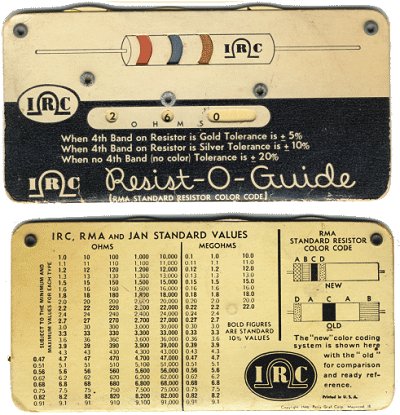
This resistance color code wheel chart was the most common electronic wheel chart.
Probably the most widely used electronic wheel chart that many of us used in school was the resistance color code wheel chart. There were many versions, but most operated similarly. They usually had three wheels to select and convert the three color bands on a carbon resistor to its resistance value. Many were given out as promotions by the resistor manufacturers; still others were sold by electronics distributors for many years.
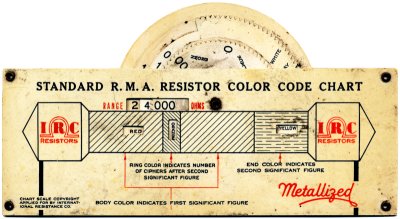
This IRC wheel chart shows the resistance color markings for early “dog bone” resistors.
In the 1920s and early 1930s, many resistors were shaped like dog bones. These “dog bone” resistors did not have the typical color bands you see today. The value was stated on many by the end color, main body color, and the color of a ring or dot in the middle. Early resistance wheel charts for dog bone resistors are scarce today. The few dog bone resistance calculators I have found were in early tube testers that had not been used for 80 or so years. These types of wheel charts were also made for finding capacitor color code values. Today these early calculators sell for $10 to $25, depending on subject and condition.
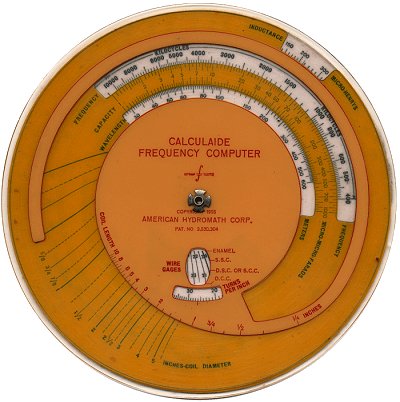
The Calculaide Frequency Computer wheel chart by American Hydromath Corp. was produced in 1955.
In the mid 1950s, the Calculaide Frequency Computer computed the frequency and wavelength of a coil and condenser circuit by rotating the wheel to select physical dimensions of the coil and the value of the condenser. This wheel chart was 6 inches in diameter.
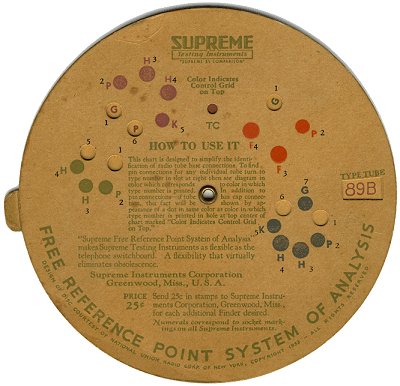
Supreme's Free Reference Point System Disk for vacuum tube testing.
During the 1930s, Supreme Instruments supplied a “Free Reference Point System Disk” with many of their vacuum tube testers and radio analyzers. This two-sided disk allowed easy identification of which tube pin jacks on the tester to use by rotating the inner wheel to the tube number under test. The wheel would then give a visual indication of which tube pins needed to be tested.
Slide Charts
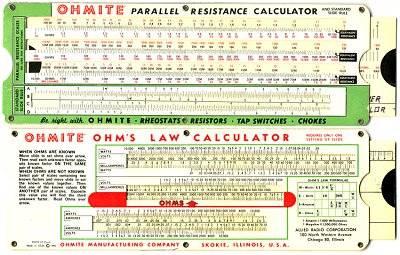
A typical slide chart, the Ohmite Parallel Resistance Calculator.
Slide chart calculators resembled a slide rule. By sliding the inner card side to side or up and down, calculations or specifications would appear in cutout windows. Most slide charts were two sided and provided different calculations or operating instructions on the back. The Ohmite slide charts are probably the most commonly found and usually only sell for a few dollars.

The RCA Pindex slide chart — 1936.
The RCA Pindex slide chart gave pinouts and tube data for RCA Radiotron vacuum tubes on both sides with instructions on the back. The chart indicted the plate, cathode, grid, and filament or heater pins on each tube type along with voltage, current draw and other important operating data. This early RCA slide chart is fairly rare and valued by vacuum tube collectors, so expect it to sell in the $15 to $35 range, depending on condition.
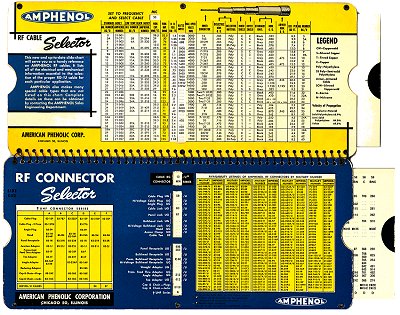
Amphenol RF Connector and Cable Selector — 1954.
The RF Connector and Cable Selector produced by Amphenol in the 1950s is a spiral-bound, double-slide card. Two cards are attached like a spiral notebook. One card is a slide chart for selecting the proper Amphenol RF connector and cable, the second provides a cross reference to RF cable and cable assemblies.
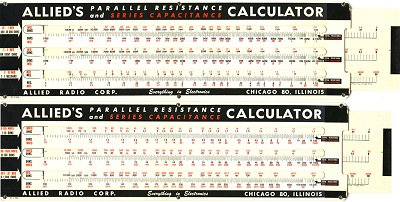
The Allied Radio Resistance Capacitance Calculator.
The Allied Radio Resistance Capacitance Calculator is double sided and has three different ranges on each side. It calculates both parallel resistance and series capacitance. You slide the card so two values are lined up then follow the arrow on the right side and use the red scales to compute parallel resistance and the black scales to find series capacitance. This slide card still comes in handy today.
Old wheel chart technology meets new technology
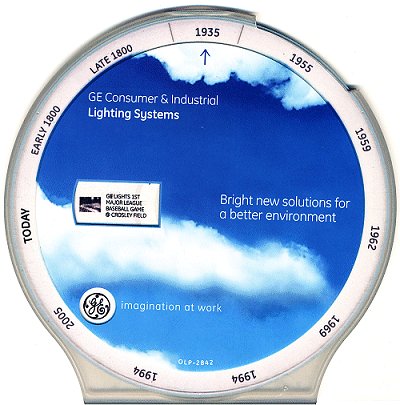
This General Electric digital disc wheel is a wheel chart printed on a DVD.
The idea of a wheel chart is still in use today using current technology.
The “DigitalDiskWheel” is a proprietary DVD case that contains an actual DVD. Rotating the DVD in its cover allows product data to be calculated and displayed. The DVD itself may also contain additional data, catalogs, and product literature, or any additional digital information a company might want to provide its customers. More information may be found at digitaldiscwheels.com.
For more information and examples of many additional electronic-related cardboard calculators, wheel charts, and slide charts view my collection at StevesAntiqueTechnology.com.
Advertisement
Learn more about Electronic Products Magazine





